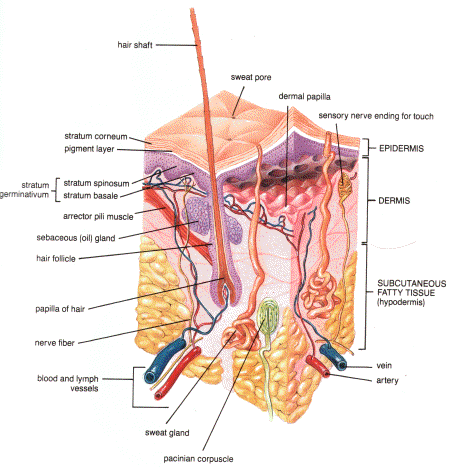How Skin Heals
Over the years I've been
Dear Hatchling #3:
Remember that patient we did a home visit on back when you were in the office with me? The diabetic amputee with the wound on her (one remaining) leg that wouldn't heal? Well, the good news is that it finally healed. The bad news is that she spilled some hot gravy on her lap while cooking (since she has to do everything from a seated position) and sustained some nasty burns to her thighs a few weeks back.
The really good news is that they were fairly shallow second degree burns. This means that the epidermis was destroyed and sloughed off as blistering, leaving the underlying dermis exposed, painful and vulnerable to infection. All I did was keep the wounds clean and dressed them with an antibacterial/vaseline coated gauze while they healed, which they did beautifully after about two weeks. I went back to see her once or twice a week to make sure they weren't getting infected or anything (they didn't) and were healing ok (they were.)
By the last visit, the wounds had healed completely. If you ran your fingers over the skin, it was smooth; completely epithelialized, but its appearance demonstrated something really cool about the anatomy of the skin that I wished I could show you. Then I thought of a way I could: after asking the patient's permission, I whipped out my trusty cell phone and voila!

Going back to the anatomy of skin, recall that the epidermis doesn't sit flat on top of the dermis like a bedspread. Rather, the dermis has little fingerlike projections that poke up into the epidermis, kind of like a foam "eggcrate" mattress; pink in this picture:

The epidermis and top of the dermis were destroyed by the scald wound, but the three dimensional structure of the dermis meant that there were regularly arrayed indentations where little bits of the basal layer were preserved. Those little brown/black dots you see represent the migration of pigment cells from the dermal crypts moving up and spreading out into the newly regenerating epidermis. Eventually, the area's pigmentation will become uniform, as the "dots" appear to spread and coalesce. That's what "healing without scarring" means.
Hope second year is going well for you.
Best,
Dr. Dino
Edited to add Hatchling Index:
Hope second year is going well for you.
Best,
Dr. Dino
Edited to add Hatchling Index:
- KK
- JB
- CW











10 Comments:
I like this letter.
*Gasp!* It's not the most pleasant, fun, exciting experience in the world to have medical students with you?
Seriously, though, it's important. My FP rotation was what made me want to go into it.
That's really interesting. I bet you're a pretty cool and informative preceptor.
Hatchlings grow into Baby dinos...I like it.
Nice post.
Dino is an excellent teacher. I remember the patient well and am glad you shared this with me. As usual, I learned something new.
I hope everything is well with you. I will stop in after exams.
Thanks,
Hatchling #3
hmm the good old days when you could sleep until 7:30AM... how I miss a good nights sleep.
Seriously though if I go the FP root to Sports Medicine, Dr. Dino will be the reason.
The Hatchling (1?)
Wondering if any of the Hatchlings suggested that the Dino check the patients Vit D 25-OH level.
That would have made for an interesting conversation...would the student have become the teacher? :)
Diabetic wound that won't heal.... D deficiency doesn't get more symptomatic than that.
Now that was a good read! Good job - nice description. Not sure what impressed me more - the knowledge or the fact that you made a house call. Nice!
While on the subject of skin I heard a good tip last week. If the bottoms of your feet are rough, use something like a Clearasil Cleansing pad with the 2% salicylic acid. Wipe the bottom of your feet. Let them dry, then put on a heavy cream and some socks. Oh yeah, do this at night before you go to sleep. Within a few days your rough, dry feet will be nice and soft once again.
woohoo I'm #1 at something (finally)!
and back to studying for Surgery
The Hatchling
Cool post. I'm a dermatopathologist, and one dermatologist at a conferene I attended talked about how you could treat vitiligo by doing hair transplants into the area (because the melanocytes from the epithelium around the transplanted follicle would migrate up and spread out into the affected area). Pretty cool, although nobody really treats it that way (expensive and not that many people know how to do hair transplants).
Post a Comment
<< Home